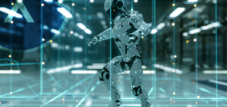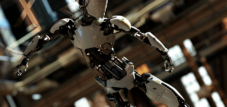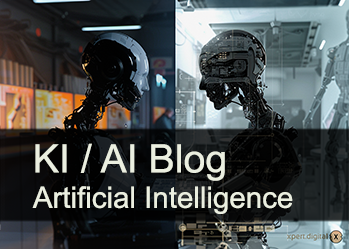RealMan Data Training Center for Humanoid Robotics in Beijing – In this mega-center, 108 robots learn for our everyday lives
Language selection 📢
Published on: September 1, 2025 / Updated on: September 1, 2025 – Author: Konrad Wolfenstein

RealMan Data Training Center for Humanoid Robotics in Beijing – In this mega-center, 108 robots learn for our everyday lives – Creative image: Xpert.Digital
China's master plan: With this center, Beijing wants to become the global center for humanoid robots
### More than just code: How "embodied AI" is now teaching robots to understand the real world ### The tipping point has arrived: Why humanoid robots will change the world of work by 2025 ### Robots instead of caregivers? China's new training center is preparing humanoid helpers for elderly care ###
From 80,000 to 55,000 dollars: The price of humanoid robots is falling – this is what it means for us
The era of humanoid robots is no longer a distant dream; it is beginning now. In Beijing, the Chinese company RealMan Robotics has opened a groundbreaking data training center designed to bridge the gap between laboratory research and real-world applications. Across 3,000 square meters, 108 robots of various designs train in ten realistically simulated scenarios—from elderly care to retail to automotive production. The goal: to generate vast amounts of high-quality, multimodal data to massively accelerate the development of so-called "embodied AI."
This technology enables robots to learn through physical interaction with their environment and adapt to unpredictable situations – one of the biggest hurdles facing robotics to date. The center thus addresses core problems such as the lack of transferability of learned knowledge to new situations and the gap between simulation and reality. This project is not only a technological milestone but also a clear signal of China's ambition to become a global center of excellence for robotics by 2029 and to lead the next industrial revolution. It marks the beginning of a new phase in which humanoid robots will increasingly shape our working and living environments.
Suitable for:
What is the RealMan Data Training Center for Humanoid Robotics?
Why did RealMan open such a center in Beijing? The answer lies in the rapid development of humanoid robotics, which is currently moving from research labs to real-world applications. The Chinese company RealMan Robotics officially opened a data training center for humanoid robotics in Beijing on August 24, 2025. This center represents a significant step toward bringing the technology from experimental environments into everyday and industrial applications.
The center serves as an innovative hub, combining research and development with scenario-based application testing, operator training, and ecosystem collaboration. As the central technology and equipment provider, RealMan Robotics plays a crucial role in both the construction and day-to-day operation of this facility. The initiative aims to advance the use of humanoid robot technology in both everyday life and industry.
What are the center's technical specifications?
How big is the center and what does it contain? The Data Training Center covers an area of 3,000 square meters and is strategically divided into two main areas: a training area and an application area. This division allows for both theoretical training and practical testing in realistic scenarios.
At the time of opening, 108 robots of various designs were already in operation. This impressive robot fleet includes various types designed for different tasks: two-arm robots for handling tasks, humanoid robots on wheels, drone-assisted robots, and four-armed robot platforms. The variety of robot types allows for testing different application scenarios and collecting multimodal data.
Which areas of application are simulated in the center?
Which real-life situations can be recreated at the center? To ensure data quality and provide practical scenarios, the center replicates ten realistic application areas. These carefully constructed environments include elderly care and rehabilitation, retail, automotive production, intelligent catering, special operations, and other areas.
The selection of these scenarios is strategic. They represent areas where humanoid robots could have the greatest practical benefits. In the field of geriatric care, for example, robots can be tested in assisting the elderly, while in retail, their customer interaction and merchandise handling capabilities can be tested.
How is data generated and used at the center?
What type of data is generated at the center, and what is it used for? The center is designed to support large-scale multimodal data generation. The various scenarios are expected to generate more than one million high-quality data points annually for training advanced AI models.
This data generation is crucial for the development of embodied AI. Multimodal data encompasses various types of information, such as visual, auditory, haptic, and motion data. This diversity enables AI systems to develop a more comprehensive understanding of their environment and respond more flexibly to different situations.
What fundamental problems does the center address?
What weaknesses in robotics does the center aim to address? The center addresses three fundamental weaknesses in industrial robotics that have so far limited the development and deployment of humanoid robots. The first weakness is the lack of data generalization across scenarios. Robots trained in a specific environment often have difficulty transferring their knowledge to other situations.
The second major challenge is the gap between simulation and realistic conditions. Many robots are developed in controlled simulation environments but do not function optimally in the unpredictable real world. The third problem is the lack of standardized data formats and efficient closed iteration loops. Without uniform standards, it is difficult to achieve systematic progress in robotics.
What is Eric Zheng's vision for the future of robotics?
What challenges does the director of the Humanoid Robotics Data Training Center see? Eric Zheng, director of the Humanoid Robotics Data Training Center, delivered a keynote speech titled "Exploring the Endgame of Robotics" at the open house. In his presentation, he identified three key areas in which robots must improve before they can be used in everyday life: usability, standardization, and cost-effectiveness.
Zheng emphasized that conventional industrial robots are heavy and expensive, while service robots remain very simple in design and most lack the adaptability of humans in complex environments. Long design times and a lack of adaptability to individual applications, combined with high costs, continue to limit adoption.
How will the RealBOT Embodied Intelligence Open Platform work?
What's special about RealMan's new platform? RealMan aims to create a foundation for overcoming the identified deficits with the "RealBOT Embodied Intelligence Open Platform." This platform was specifically developed for high-quality data collection and is intended to create new paradigms of human-robot collaboration through deep integration with remote control systems.
The platform represents an important step in the evolution of robotics from "dependent on humans" to "supporting humans" and ultimately to "empowering and liberating humans." This evolutionary approach demonstrates how the relationship between humans and robots could evolve in the coming years.
What role does embodied AI play in modern robotics?
What does "embodied AI" mean, and why is it important? Embodied AI refers to a form of artificial intelligence that is integrated into physical robots or devices and operates in the real world. The concept assumes that an AI system is equipped with a physical "body" and learns and operates through physical interactions with its environment.
This ability for physical interaction is particularly important for tasks that require human skills such as perception, motor skills, and reaction to unpredictable situations. Embodied AI has the potential to play a central role in robotics, medicine, healthcare, and many other areas, enabling robots and machines to act flexibly and dynamically in real-world environments.
Suitable for:
- A market analysis and overview of humanoid robots with a payload of 10 kg or more, for purchase and rental options
How is humanoid robotics developing globally?
What trends will shape humanoid robotics in 2025? The International Federation of Robotics has identified humanoid robots as one of the five major robotics trends for 2025. The biggest challenge will be making humanoid robots economically viable, as manufacturing costs are currently still enormous. If this is achieved, humanoid robots could revolutionize robotics.
Studies predict that 20 million humanoid robots will be in use worldwide by 2030, primarily in industrial applications. This figure is impressive considering that there are currently approximately 4.3 million industrial robots and cobots in use in factories worldwide. Technological advances in humanoid robotics are rapid, improving by 35 to 40 percent between 2023 and 2025.
What are the possible uses in the first wave?
What tasks can humanoid robots already perform today? According to experts, in the first wave, humanoid robots will primarily be able to perform logistical tasks such as sorting, transporting, and staging, or inserting parts into machines. Dozens of applications in this area already exist in series production, but currently only in companies with high volumes and low variance.
Humanoid robots could already automate up to 40 percent of tasks currently performed manually. The payback period for such investments is estimated at less than 0.56 years, making humanoid robots an attractive investment for companies. Initial industrial pilot projects have already demonstrated that investing in humanoid robots can quickly pay for itself.
What progress is planned for the second wave?
What will be possible from 2028 onwards? In the second wave, from 2028 to 2030, it is expected that even tasks with high variance, complex processes, and demanding motor skills, such as assembly, will be able to be handled by humanoid robots. Particularly in highly industrialized sectors such as the automotive industry, the use of humanoid robots can achieve significant efficiency gains.
Pilot projects have already resulted in process efficiency increases of up to 350 percent and quality improvements of over 90 percent. These efficiency gains are primarily due to the fact that the robots can be used 24 hours a day, 365 days a year. Furthermore, humanoid robots can completely eliminate human error sources.
A new dimension of digital transformation with 'Managed AI' (Artificial Intelligence) - Platform & B2B Solution | Xpert Consulting

A new dimension of digital transformation with 'Managed AI' (Artificial Intelligence) – Platform & B2B Solution | Xpert Consulting - Image: Xpert.Digital
Here you will learn how your company can implement customized AI solutions quickly, securely, and without high entry barriers.
A Managed AI Platform is your all-round, worry-free package for artificial intelligence. Instead of dealing with complex technology, expensive infrastructure, and lengthy development processes, you receive a turnkey solution tailored to your needs from a specialized partner – often within a few days.
The key benefits at a glance:
⚡ Fast implementation: From idea to operational application in days, not months. We deliver practical solutions that create immediate value.
🔒 Maximum data security: Your sensitive data remains with you. We guarantee secure and compliant processing without sharing data with third parties.
💸 No financial risk: You only pay for results. High upfront investments in hardware, software, or personnel are completely eliminated.
🎯 Focus on your core business: Concentrate on what you do best. We handle the entire technical implementation, operation, and maintenance of your AI solution.
📈 Future-proof & Scalable: Your AI grows with you. We ensure ongoing optimization and scalability, and flexibly adapt the models to new requirements.
More about it here:
Multimodal AI: The key to autonomous robot technology
When will fully autonomous robots be available?
How long will we have to wait for truly autonomous humanoid robots? Despite rapid progress, most suppliers are still in the prototype stage, and only a few companies have already established industrial production capacity. Fully autonomous humanoid robots with highly developed fine motor skills will not be widely available until 2030.
However, the first market-ready models for industrial use are expected as early as 2025. At least five manufacturers (Agility, Figure, and Tesla from the USA, as well as Unitree and Fourier from China) will begin series production in 2025. This marks the beginning of a new era in which humanoid robots will increasingly leave research laboratories and enter real-world work environments.
Suitable for:
- Flexible and modular conveyor systems – Cobots (collaborative robots) and autonomous mobile robots (AMRs) | Logistics & Intralogistics
How are the costs of humanoid robots developing?
Will humanoid robots become more affordable? The cost of humanoid robots will decrease significantly in the coming years. While the initial acquisition costs for models will average $80,000 in 2025, this is expected to drop to approximately $55,000 by 2030. This cost reduction is due to increasing competition, technological efficiency improvements, and economies of scale in mass production.
This price trend is crucial for the market penetration of humanoid robots. The more affordable they become, the more companies will be able to integrate them into their operations. The combination of falling costs and increasing performance makes humanoid robots an increasingly attractive alternative to human labor in certain areas.
What role does China play in global robotics development?
Why is China a leader in robotics development? China has established itself as a global driver of robotics development and plays a central role in the development of humanoid robots. The country is already by far the largest robot market in the world and has surpassed Germany in the use of robots in industry. With 470 robots per 10,000 employees, China is showing a rapidly increasing trend.
Beijing has made humanoid robotics a strategic priority. In January 2024, the Chinese Ministry of Industry and Information Technology published guidelines for the innovative development of humanoid robots, setting out a roadmap for industrial innovation. The goal is clear: China aims to become a "global center of excellence" for robotics by 2029.
How does the Chinese government support robotics development?
What measures is China taking to promote robotics? The Chinese government is consistently promoting the development of humanoid robots. This allows synergies to be leveraged across the entire industrial chain—all areas of the supply chain, research, and development are coordinated. This allows the country to focus on rapidly advancing robotics.
Beijing established a fund equivalent to $137 billion to support startups in the fields of AI and robotics. In addition, there are numerous local support programs. By the beginning of 2025, more than ten provinces and cities, including Beijing, Shandong, and Shenzhen, had incorporated humanoid robotics into their local economic plans. China is promoting industrial clusters focused on humanoids, particularly in the areas around Shenzhen and Hangzhou.
What is the significance of multimodal AI for robots?
Why is multimodal AI so important for robotics development? Multimodal AI is artificial intelligence that combines multiple types or modes of data to make more accurate observations, draw insightful conclusions, or make more precise predictions about real-world problems. Multimodal AI systems train on video, audio, speech, image, and text data, as well as a range of traditional numerical datasets.
Multimodal AI is crucial for robot development because robots must interact with real-world environments, with people, and with a variety of objects such as pets, cars, buildings, and their entrances. Multimodal AI uses data from cameras, microphones, GPS, and other sensors to create a detailed understanding of the environment and interact with it more successfully.
Suitable for:
- Multimodular or multimodal AI? Spelling mistake or actually a difference? How is multimodal AI different from other AI?
How does the training of multimodal AI systems work?
Which technologies enable multimodal AI in robots? Multimodal AI systems comprise various components that must work together. Natural language processing technologies provide speech recognition and speech-to-text conversion, as well as speech output. Computer vision technologies for image and video capture enable object recognition, including human detection, and distinguish between activities such as running or jumping.
Integration systems enable multimodal AI to match, combine, prioritize, and filter data inputs across different data types. This is key to multimodal AI, as integration is central to developing context and context-based decisions. Storage and compute resources for data mining, processing, and result generation are essential to ensure high-quality, real-time interactions and results.
What are the possible applications in nursing?
Can humanoid robots help in care? The number of people in need of care in Germany has doubled in the past ten years. By 2030, an additional 130,000 nursing staff will be needed in nursing homes and outpatient care nationwide, and by 2040, this number will rise to 250,000. Robots are therefore expected to take over some of their tasks, such as restocking medication stores, bringing tea, or helping to transfer seriously ill patients.
In Germany, research teams are developing humanoid and other care robots with a wide range of applications. The Fraunhofer Institute's Care-O-bot is now in its fourth generation and is being tested in the care sector. The robot can be equipped with different tools and functions as needed, making it flexible for use in both private households and care facilities.
What challenges still exist in the development of care robots?
What are the biggest obstacles for care robots? Humanoid robots are not yet used in care because they often make mistakes and stable Wi-Fi is not available everywhere. The requirements for a robot in care are significantly more complex than for industrial applications. Preprogrammed processes are sufficient there, but in care, adaptation is key: Every movement must be sensitively tailored to the specific situation and the individual.
The robot must grip securely, but never too tightly. It must be able to help without causing harm or injury. Modern care robots like AIREC therefore employ a learning system that uses sensors and deep neural networks to analyze movements, plan ahead, and precisely dose the necessary force. The developers expect a market launch no earlier than 2030, with an estimated starting price of around $70,000.
How will human-robot collaboration develop?
What stages of development does robotics go through? The development of robotics can be divided into different phases, which RealMan aims to advance with the RealBOT Embodied Intelligence Open Platform. The first stage is "human-dependent," in which robots are completely dependent on human guidance. The second stage is "human-assistive," in which robots begin to assist humans in their tasks.
The final stage is "Empowering and Liberating Humans," in which robots free humans from repetitive or dangerous tasks and allow them to focus on more creative and valuable activities. This developmental path demonstrates how the relationship between humans and robots can evolve from dependency to cooperation to a form of liberation.
What security aspects need to be considered?
How can safety be ensured when dealing with humanoid robots? It is foreseeable that limits will have to be defined for the activities of an embodied AI modeled on Asimov's robot laws to guarantee human safety. For example, certain guardrails are defined for digital AI to ensure that the basic generative models do not produce harmful results.
While China consolidates its position as a leading robotics hub, questions regarding safety, ethics, and interoperability remain regarding the use of intelligent robots. Integration into sensitive application areas such as healthcare and medicine, in particular, continues to pose a significant challenge. The development of appropriate safety protocols and ethical guidelines will be crucial for the successful integration of humanoid robots into society.
What global implications does this development have?
How will robotics developments impact the global economy? The development of humanoid robots has the potential to trigger disruptive changes. Instead of simply performing repetitive tasks as before, these robots can solve complex tasks in variable environments at a human-like level. This makes intelligent robots universal tools with a disruptive range of applications.
The RealMan Data Training Center in Beijing is more than just a single research facility—it represents a turning point in global robotics development. With its combination of comprehensive data collection, realistic test scenarios, and advanced AI integration, it could serve as a model for similar facilities worldwide. The insights gathered and technologies developed here are likely to have a significant impact on the future of human-robot interaction, paving the way for a new era of embodied intelligence.
EU/DE Data Security | Integration of an independent and cross-data source AI platform for all business needs
Ki-Gamechanger: The most flexible AI platform-tailor-made solutions that reduce costs, improve their decisions and increase efficiency
Independent AI platform: Integrates all relevant company data sources
- Fast AI integration: tailor-made AI solutions for companies in hours or days instead of months
- Flexible infrastructure: cloud-based or hosting in your own data center (Germany, Europe, free choice of location)
- Highest data security: Use in law firms is the safe evidence
- Use across a wide variety of company data sources
- Choice of your own or various AI models (DE, EU, USA, CN)
More about it here:
We are there for you - advice - planning - implementation - project management
☑️ SME support in strategy, consulting, planning and implementation
☑️ Creation or realignment of the AI strategy
☑️ Pioneer Business Development
I would be happy to serve as your personal advisor.
You can contact me by filling out the contact form below or simply call me on +49 89 89 674 804 (Munich) .
I'm looking forward to our joint project.
Xpert.Digital - Konrad Wolfenstein
Xpert.Digital is a hub for industry with a focus on digitalization, mechanical engineering, logistics/intralogistics and photovoltaics.
With our 360° business development solution, we support well-known companies from new business to after sales.
Market intelligence, smarketing, marketing automation, content development, PR, mail campaigns, personalized social media and lead nurturing are part of our digital tools.
You can find out more at: www.xpert.digital - www.xpert.solar - www.xpert.plus






























